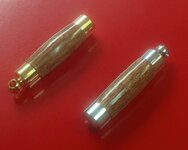rjustice21
Member
- Joined
- Apr 14, 2014
- Messages
- 7
Hello all,
I have been browsing this forum for some time and have a question pertaining to CA finishes. Currently, I am getting cloudy results. Searching through the forums I gathered that it is most likely due to moisture getting into the wood or old CA. I have some questions;
-How old is too old for the CA? I have seen many people advise people to keep the CA fresh, but what is "fresh"?
-How long do you wait between CA coats? I am leaning towards waiting longer to ensure that the CA cures. Would putting CA coats on too quickly produce cloudy spots?
My process is;
-Turn pen
-Clean with mineral spirits (I'm going to switch to DNA to see if that makes any difference)
-Sand up to 600 grit (sanding longways at the end of each grit)
-Seal with thin super glue
-10-15 coats of thing super glue
-wet MM through all the pads
-buffing compound
Any help would be appreciated. Looking forward to learning better methods. Thank you and have a great day.
I have been browsing this forum for some time and have a question pertaining to CA finishes. Currently, I am getting cloudy results. Searching through the forums I gathered that it is most likely due to moisture getting into the wood or old CA. I have some questions;
-How old is too old for the CA? I have seen many people advise people to keep the CA fresh, but what is "fresh"?
-How long do you wait between CA coats? I am leaning towards waiting longer to ensure that the CA cures. Would putting CA coats on too quickly produce cloudy spots?
My process is;
-Turn pen
-Clean with mineral spirits (I'm going to switch to DNA to see if that makes any difference)
-Sand up to 600 grit (sanding longways at the end of each grit)
-Seal with thin super glue
-10-15 coats of thing super glue
-wet MM through all the pads
-buffing compound
Any help would be appreciated. Looking forward to learning better methods. Thank you and have a great day.

